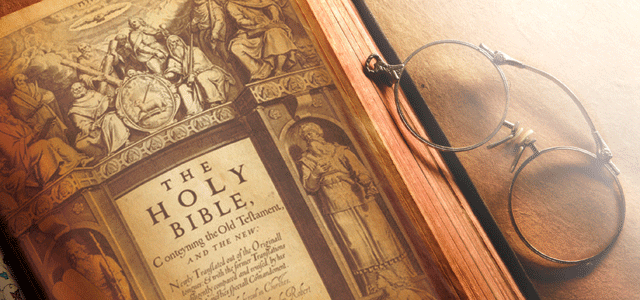The Story of the King James Bible
May 2, 2011

The Authorised Version—better known as the King James Version—of the Bible was first published in 1611—exactly 400 years ago this year. Historical records are inadequate to determine the exact day or even the month when it was published. Only the year is certain.
When it first appeared, Europe in general and England in particular had not long emerged from centuries of medieval ignorance and superstition. There had been various protests at papal excesses and inconsistencies through the centuries, but by the early sixteenth century, a major revolt was inevitable and it came in the form of the Protestant Reformation. Led initially by Martin Luther in Germany, it quickly spread across much of Europe.
During the long medieval period, the Bible was literally a closed book, unknown to the vast majority of European people, most of whom were illiterate anyway. Before the invention of the printing press—about 1440—the Bible was available only in manuscript form, only in Latin and only to the few better-educated priests. Church services were conducted in Latin and were unintelligible to almost all parishioners. The widespread ignorance and frequent corruption of the parish clergy made matters worse.
Beginnings
Protestant church historian Roland Bainton commented, “The Reformers dethroned the pope and enthroned the Bible.” As the Reformation progressed, the Bible was translated into the languages of the people in many European countries. Over in England, reformers such as John Wycliffe and his followers and scholars like William Tyndale published early English translations of parts or the whole of the Bible.
But when James I came to the throne in 1603, it was evident that no existing version of the English Bible was acceptable to all parties in the English church. A new version was needed to bring unity to the church and the nation. The decision to proceed was made in 1604 at the famous Hampton Court Conference. It was to be endorsed by King James, who was a keen and accomplished Bible student, and firmly believed that earlier versions were inadequate since they were not in all respects true to the original languages.
Work eventually began in 1607 in accordance with a process that set the pattern for future major translations. It was to be undertaken by a large and representative team of well-qualified scholars, rather than by one or two individuals. In this way bias would be eliminated or countered and the objective of the enterprise assured. They set out to produce a version of the Bible that was moderate, leaning neither to the left nor the right, neither to Puritanism nor Catholicism.
The six groups were to work in accordance with a set of guidelines drawn up by Richard Bancroft, the new Archbishop of Canterbury, and approved by the king. The first and most important rule stipulated that the new version was to be based on the earlier translation known as the Bishops’ Bible and “as little altered” from it “as the truth of the original will permit.” In other words, it was to be a revision rather than a new translation, a fact frequently forgotten.James himself specified that “the best learned in both universities” should make up the translation team and accordingly most of the leading biblical and oriental scholars from Cambridge and Oxford were appointed, together with a few suitably qualified laymen. There were 47, or perhaps 48, Anglican and Puritan, carefully chosen for their skills. They were divided into six groups, each responsible for a section of the Bible, with their work to be submitted for final approval to a team of 12, composed of the two leading members of each of the six teams. The final revision was to be approved by the king and his council.
Reference to earlier English versions was permitted, even encouraged. Rule 14 specified which of the previous English versions might be consulted, and all were named, except that of Taverner. Reference to those original Hebrew and Greek texts that were available was also encouraged. German and French translations were also consulted.
The translators set out their objectives quite clearly in their introduction: “We never thought that we should need to make a new translation,” they wrote, “but to make a good one better, or out of many good ones, one principal good one.” Christian theologian and apologist Alister McGrath’s pithy phrase sums it up well. The translators of the Authorised Version had been “standing on the shoulders of giants.”*
The guidelines further laid down that existing chapter and verse divisions should be retained, that only marginal notes which explained difficult Hebrew and Greek words be included and that the widest possible consultation should take place at every stage in order to ensure the accuracy of the text and its faithfulness to the original languages. The outcome of this structured and well-supervised process was exactly what had been intended—a better version of the English Bible than any previously issued.
Word accuracy
The Authorised Version was what is now known as a “formal” translation, the most distinguished in a long line of such translations that has continued until the present day. Wherever possible, it attempted to ensure that every word in the original was translated by an equivalent English word.
This word-for-word approach required a careful balancing act. While the meaning of the original language takes precedence, the receptor language must also be accurate and intelligible. Words in the translation that were not in the original were generally shown in italics in the translated text. One writer observes, “Such understanding is found in the King James Bible, which retains the word order of the original to a remarkable extent, while still making allowances for the resulting text to be, in the first place, recognisably English and in the second, intelligible.”
An important result of this way of translating is that a large number of Hebrew and Greek words and idioms have passed into the English language and thence into all succeeding English literature. It is just one way in which the Authorised Version has influenced the development of the Western world.
Finding understanding
When talking about the Bible, you will hear terms such as Old Testament, New Testament and even Torah. What does it all mean?
Old Testament: The Old Testament, or OT, consists of 39 books spanning from Genesis to Malachi. Largely about the history of ancient Israel and God’s instructions to the nation, its overarching theme points to the coming of Jesus to save the world from sin.
New Testament: The New Testament, or NT, is located in the second half of the Bible. It consists of 27 books, beginning with Matthew and ending with Revelation. It is a collection of works, written in the first century a.d. by various authors. It revolves around the life, teachings and death of Christ and is the basis of today’s Christian theology and practices.
Torah: Also known as the Pentateuch, they are the first five books of the Old Testament (Genesis, Exodus, Leviticus, Numbers and Deuteronomy) written by Moses. Its teachings form the foundations of Judaism and modern Christianity. Jesus quoted extensively from it in His ministry.
Gospels: Refers to the first four books of the New Testament (Matthew, Mark, Luke and John) that detail the life, teachings and death of Jesus.
Apocrypha: These are books that are considered useful but not divinely inspired. They are not included in the Protestant Bible.
Influence today
This truly great version of the English Bible made a significant impact on the development of Western civilisation. This sometimes seems more-readily recognised by the enemies of that civilisation than some who live within its boundaries and benefit from its many advantages. When we celebrate the Authorised Version, we celebrate who we are and where we have come from, perhaps without even knowing it.
The great English biblical scholar of an earlier age, Sir Frederic Kenyon, to whom all later biblical scholars owe an immense debt, wrote of the Authorised Version, “It has been the Bible, not merely of public use, not merely of one sect or party, not even of a single country, but of the whole nation and of every English-speaking country on the face of the globe. It has been the literature of millions who have read little else, it has been the guide of conduct to men and women of every class in life and of every rank in learning and education. . . . It was the work, not of one man, nor of one age, but of many labourers, of diverse and even opposing views, over a period of 90 years. It was watered with the blood of martyrs, and its slow growth gave time for the casting off of imperfections and for the full accomplishment of its destiny as the Bible of the English nation.”
McGrath recently put it more briefly: “Our culture has been enriched by the King James Bible. Sadly, we shall never see its equal—or even its like—again.” If the Bible is indeed the Word of God, that Word must be communicated in the language of the people. That principle has been understood by all translators of the Bible since the time of the reformers, and it still holds today. It explains in part why there have been so many new translations in recent times and why they continue to roll from the presses and publishing houses throughout the English-speaking world.
While the influence of the Authorised Version can never be diminished, its meanings can often be clarified with the help of more recent translations. Those who wish to read and understand God’s Word from its pages can, of course, still do so. That the Bible is available to us in so many translations and versions is a great advantage, and that we are free to read it is one of the great benefits of living in a free society and one not to be neglected.






